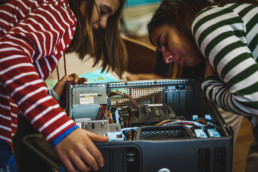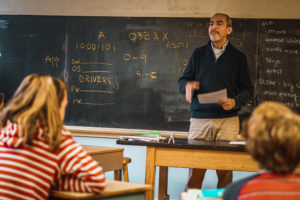
“Where do you see or use computers in your life?” Fausto Rivera asks the seventh grade class at the Susquehanna Waldorf School. At first, the students ponder the question quietly, exchanging a few thoughtful glances with their peers as they ponder their responses. “ATMs,” one student announces. “Toll booths,” another adds. “Cars.” “Phones.” “Healthcare.” What begins slowly quickly mounts into a lengthy list of daily applications for the technology. “These are fantastic answers!” comments Mr. Rivera. “Now, let’s actually open a computer up, and see how it works.”
Led by the expertise of Mr. Rivera, an expert Technologist with a degree in Systems Engineering, the students take their Cyber Civics program above and beyond the textbook. Separating into two groups, the students, without the aid of any tools, are tasked with opening up computers and locating various vital components that have been discussed throughout their study. The Cyber Civics course isn’t only about being able to understand the physical parts. It is approached the same way any other subject is undertaken in Waldorf education: by understanding what, how and why they use something, from the inside out. Aside from this study, computers are not present in early childhood and elementary Waldorf classrooms, and media use in ge neral is discouraged, even in the home. Reliance on picture and images from screens can reduce a child’s ability to visualize their own thoughts and imagination. Because the cultivation of the imagination is paramount in Waldorf education, media mindfulness is practiced to strengthen creativity and foster deepened focus, critical components to an education that develops innovative thinking.
neral is discouraged, even in the home. Reliance on picture and images from screens can reduce a child’s ability to visualize their own thoughts and imagination. Because the cultivation of the imagination is paramount in Waldorf education, media mindfulness is practiced to strengthen creativity and foster deepened focus, critical components to an education that develops innovative thinking.
In the case of computers in the Cyber Civics course, the goal is to understand the history, evolution and physical components of computers, weaving everything together into a complete picture so that students can use the technology safely, effectively, creatively and wisely and grow into healthy, ethical digital citizens. “For a child, a computer is merely a toy,” says Leilani Richardson, Class 7 teacher. “At this age, and as they begin to enter adulthood and have more responsibilities around life, students now use  computers for non-recreational purposes. It becomes a tool. We want to extend their digital literacy skills so that they are prepared to use this tool for life.”
computers for non-recreational purposes. It becomes a tool. We want to extend their digital literacy skills so that they are prepared to use this tool for life.”
As the class nears its close for the day, the students engage in a final hands-on exercise. Mr. Rivera asks the class to gather around as he lifts the lid to a computer server and presses the “on” switch; instantly, the server whirs to life, small orange and green lights twinkling across the board like a miniature city. “If you are going to teach Civics,” says Matt Bei of the New York Times, “then as part of Civics you ought to be teaching media.” At a time when the presence of digital media permeates seemingly every sphere of life, with children (and adults) around the world being conditioned to passively let technology control them, teaching young students that they can make healthy choices around computers has enormous implications for their own well-being, as well as the well-being of the greater community.
